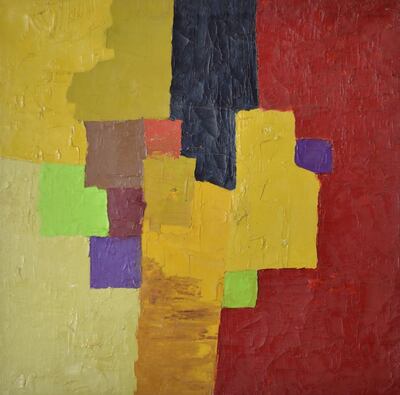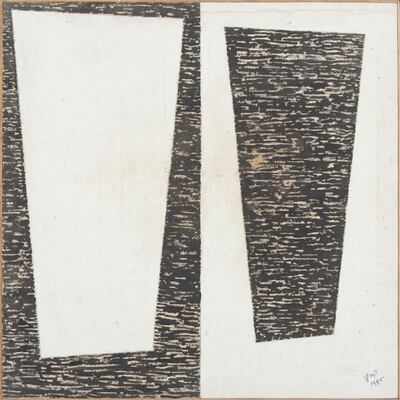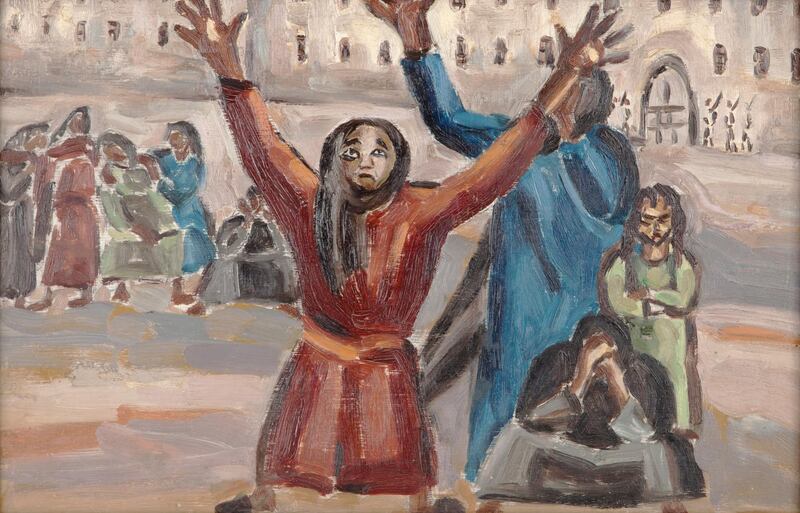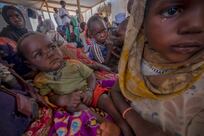The opening of the Barjeel Art Foundation’s collection at Sharjah Art Museum this past weekend sheds light on a field of art history that has too long been sheltered from permanent public view: the politically engaged, passionately executed and visually stunning works of Arab Modernism.
The foundation has installed its works in a series of galleries at the museum on long-term loan, for artists, students and the general public to return to again and again.
“This is the first in the UAE,” Salwa Mikdadi, one of the co-curators of the exhibition, tells me from her office at New York University Abu Dhabi, where she is a professor of global art history. “I’m sure. I checked. There’s no one else who’s done it.”
The partnership between the Barjeel Art Foundation and Sharjah Art Museum will include more than 120 paintings and sculptures from the Barjeel collection.
The exhibition, which Mikdadi curated with Mandy Merzaban, Barjeel’s founding curator, and Karim Sultan, Barjeel’s director, is arranged thematically, showing Arab Modernism’s diversity of works and approaches, as well as its various centres, from Casablanca to Baghdad. The Barjeel Art Foundation is headed by Sultan Sooud Al Qassemi, a writer, political thinker, and researcher on art and urbanism.
The intertwining of art and life
The intertwining of art and politics runs throughout A Century in Flux: Highlights from the Barjeel Art Foundation. Mikdadi characterises the collection as "driven by historical signposts: art history, but also political history".
The show is particularly strong on the work from the 1950s to 1970s, with iconic pieces such as Kadhim Hayder's Fatigued Ten Horses Converse with Nothing (1965), Ibrahim El-Salahi's The Last Sound (1964) and Dia Azzawi's A Wolf Howls: Memories of a Poet (1968).

During this period, artists intensely engaged with political struggles, reflecting them in powerful works whose messages would have been immediately legible to those around them. The Egyptian artist Inji Efflatoun was imprisoned by Gamal Abdel Nasser's government; friends smuggled crayons and oils to her in jail and Prisoners (1957) was one of the works she produced.
The Iraqi labourer at the centre of Hayder's He Told Us How It Happened (1957) radiates physical strength; Hayder shows him nearly boxed by the drawings and text at the painting's edges that recount the violent repression of the working class by the Hashemite monarchy, who were overthrown the following year.
Later, in Fatigued Ten Horses, Hayder uses the Battle of Karbala as an allegory for the 1963 coup in which artists and dissidents were killed.
Although it is not designed to be a survey, the exhibition covers key moments in Arab Modernism: from the early period, which was centred in Cairo, through its soft cityscapes and portraits with revealing details, to the paintings in which the iconography of Arab nationalism was created, with motifs such as the heroic fighter or Arabic brothers shown in unity.
The ethereal, deftly balanced rays of abstraction, produced by the Casablanca School and in Lebanon in the 1960s and 1970s, by artists such as Etel Adnan, Saloua Raouda Choucair and Saliba Douaihy, float across the galleries to trade hellos.
“I want to force the visitors to make the connections,” says Mikdadi. “It’s a show for the good visitor over repeated visits.”

Later pieces show artists from the Gulf, such as those in Kuwait in the 1960s, and in the UAE, such as Rais and Hassan Sharif, who worked in Sharjah in the 1990s.
The importance of being seen
One persistent problem faced by those curious about Arab art history has been a relative lack of public institutions in which to view the work. Many major collections are privately held, such as Barjeel's, but the owners have not shared its commitment to public exhibition. Large-scale public institutions are few, or, like the modern museums of Baghdad and Cairo, have materially suffered from periods of tumult in their host countries.
Sharjah, the historic centre for contemporary art in the UAE, has been the exception. Culture in the emirate has been well-supported by public institutions, although the focus has mostly been on international touring and short-term exhibitions.
The Sharjah Art Foundation has a generous loan policy for its permanent collection, and, like most top-tier institutions, prefers not to do shows drawn solely from its collection.
Likewise, the Sharjah Art Museum, which has a sizable permanent collection, is best known for the temporary exhibitions that it has hosted; this collaboration gives the public a chance to deepen their understanding and engagement with these works.
“The Sharjah Art Museum has a 20-year history of organising numerous exhibitions of Arab artists that are also represented in the Barjeel collection,” says Manal Ataya, director-general of the Sharjah Museums Authority. “This exhibition allows us to continue that conversation and highlight how their practice has influenced contemporary artists today. Their body of work reflects significant historical sociopolitical events that have played a critical role in shaping our collective identity.”
This difficulty in getting to see the work has been compounded by a lack of interest on the part of the western art community for the work, either in terms of hosting shows or funding research, although this is beginning to change.
Mikdadi was long one of the few voices of advocacy: she curated her first show, of Palestinian artists – before, she says, she knew the word “curator” – as a student in Beirut in 1968.
“Salwa Mikdadi has invested decades in learning about modern Arab art and was a pioneer in showcasing Arab art in the US,” says Al Qassemi. “In addition to being a respected professor of art history she has an understanding of Arab culture and political dynamics that is essential to understanding the region.”
_______________
Read more:
Barjeel Art Foundation curators reflect on the West's reactions to Arab art
Sultan Al Qassemi: Taking a 'Warrior’s Break'
Major exhibition of Arab art from the Barjeel Foundation opens in Paris
_______________
Mikdadi says she rebuffed Al Qassemi’s invitations to curate a show for him several times, but when he impressed on her the seriousness of his long-term partnership with the museum, she says, “I was sold.” “I said, ‘This is the person I want to work with.’ For years I’ve been asking all these collectors, ‘What are you going to do with your collection? Are you going to donate it to a museum?’ They look at me like I’m a crazy person. But, I will do it for him. When he asked me, I said OK.”
It is also the end of a stage for the Barjeel Art Foundation – reflected in the show's name in Arabic, Maseerat Qarn, or the "journey of a century".
Merzaban has been instrumental at all the milestones of Barjeel: she curated its first ever, its first modern and its first international shows – and now its last, in Barjeel's current form – and traces an arc from contemporary to modern.
"We launched in 2010 with Peripheral Vision, which was mostly contemporary works," Merzaban says. "In 2013, we did Re:Orient, which was our first step into exploring modernism in the Arab world."
The foundation's year-and-a-half-long show at the Whitechapel Art Gallery in 2015-17 made a big impact not only in London, but in the international press, and the foundation's ambitions intensified in modernism and international touring.

Now with its focus shifted to near-permanent exhibition, it and the museum's ambitions remain large: by focusing on Modernism, a period dominated by western artists, the show reveals 20th-century art as an equal conversation among artists across the globe.
“There is a particular kind of authority you encounter when you first start studying art history,” says Merzaban. “It feels like the narrative is established and universally accepted in a way. Initially, I didn’t realise what I was hearing was a monologue from Lascaux to Klee. When in fact, it’s a dialogue.”
A Century in Flux: Highlights from the Barjeel Art Collection is at the Sharjah Art Museum till 2023






